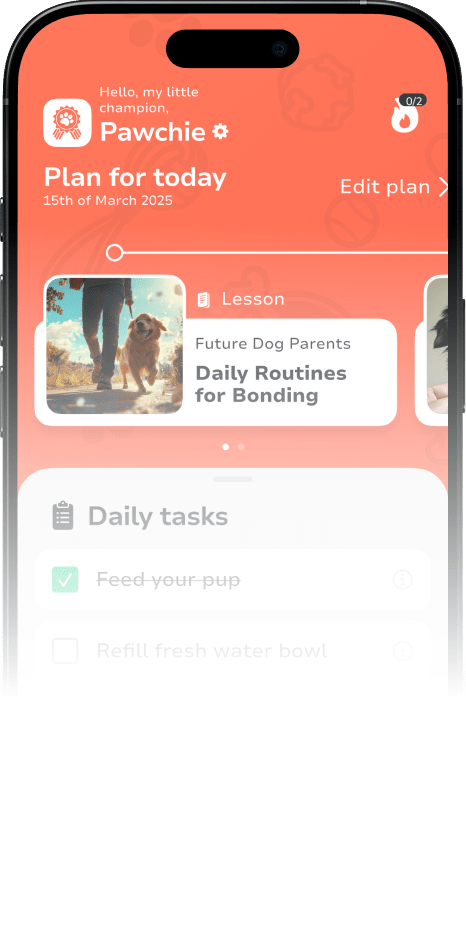Effective management of dogs goes beyond feeding and walking. It means understanding your dog’s health, behavior, and environment to help them thrive. A good training plan, balanced diet, preventive vet care, and consistent routines make every dog owner more confident and every pet healthier and happier.
Key takeaways for successful dog management:
Establish consistent daily routines for feeding, exercise, and care
Implement preventive healthcare measures, including regular vet checkups and vaccinations
Create a safe, comfortable living environment tailored to your dog’s needs and consider your dog's lifestyle when establishing routines and spaces
Develop effective training and socialization strategies from day one
Maintain proper nutrition and exercise programs based on your dog’s age and breed
Stay prepared for emergencies and know when to seek professional help
Daily Dog Care and Routine Management
Caring for your dog means creating a predictable structure for feeding, exercise, and rest. Adult dogs thrive on consistency—it keeps anxiety low and helps them behave better.
Food
Feed high-quality dog food two to three times daily, always in clean food and water dishes, and check that the portions fit your dog’s lifestyle, breed, and activity level. Puppies usually need three to four meals per day until their growth stabilizes.
Fresh water should always be available. Wash bowls daily to prevent bacteria from spreading and keep your dog’s health protected. A consistent feeding schedule also helps monitor appetite, which is often the first sign of illness.
Exercise and Activity
Proper exercise is essential for keeping your dog fit and emotionally balanced. Most dogs need between 30 minutes and two hours of activity each day depending on their breed and energy level. Walks strengthen your bond, offer mental stimulation, and help reduce behavior problems like destructive behaviors or excessive barking.
Use a sturdy leash to maintain control, especially if you have a reactive dog or walk in busy areas. Dogs with high energy, such as herding breeds, benefit from advanced activities like agility, fetch, or running games, while smaller breeds and senior dogs need gentler options like short walks and indoor play.
Exercise also includes mental challenges—puzzle toys, scent games, and obedience exercises engage your dog’s mind, reducing boredom and anxiety. The PawChamp app offers a guided Mental Stimulation Challenge course designed to calm restless dogs by providing them with the mental work they crave. This course will teach your dog to think, focus, and solve small challenges through short, home-friendly games.
Grooming and Hygiene
Regular grooming keeps your dog’s coat, skin, and overall health in good condition. Brush two to three times per week to remove dirt, tangles, and loose fur. Most dogs need baths every 4–6 weeks, but over-bathing can dry their skin. Always use dog-specific shampoo and rinse thoroughly around the neck and ears.
Long-haired breeds may need daily brushing and professional trimming. Use electric clippers for thick coats to prevent pulling or injury. Check ears weekly for odor or discharge and clean with vet-approved solutions to prevent infection. Trim nails every two to four weeks so they don’t split or affect your dog’s gait.
Dental hygiene is critical—brush teeth several times a week to prevent tartar buildup and gum disease. Regular vet cleanings help detect serious diseases early.
Rest and Sleep
Just like humans, adult dogs need 12–14 hours of sleeping daily. Create a quiet house space with a comfortable bed where your pet can relax. Puppies and senior dogs may need even more rest. A structured sleep schedule supports both behavior and immune function.
Nutrition and Feeding Management
Good nutrition is the foundation of a healthy life. Choose premium dog food that meets AAFCO standards, appropriate for your dog’s age, size, and activity. Puppies need higher protein and fat content, while senior dogs often benefit from joint-supporting ingredients and easily digestible formulas.
Feed consistent portions and avoid free-feeding to prevent obesity. Most dogs become overweight when treats or table scraps exceed 10% of daily calories. Use small treats like cooked chicken or carrot sticks during training, but adjust meal sizes accordingly.
When switching brands or formulas, transition gradually over 7–10 days to avoid diarrhea or digestive upset. Always monitor your dog’s health—changes in appetite, energy, or bathroom habits can indicate health issues.
Avoid toxic foods such as chocolate, grapes, onions, and xylitol, which pose severe risk to dogs’ health. These can cause organ failure or even death, especially in male dogs and female dogs of smaller breeds.
Health Management and Veterinary Care
Preventive healthcare keeps your dog strong and helps avoid serious diseases. Regular veterinarian visits, x-rays, and wellness exams are essential. Puppies need vet checkups every 3–4 weeks until four months old, while adult dogs should go annually, and senior dogs every six months.
Vaccinations guard against common diseases like distemper, parvovirus, and rabies. Year-round parasite control is non-negotiable—use vet-approved preventives for fleas, ticks, and heartworms.
Keep detailed health records, including symptoms, medications, and visit dates. Track your dog’s weight monthly; over 50% of dogs in the U.S. are overweight, increasing risk of joint issues, diabetes, and heart problems.
Recognizing Health Issues
Dogs often hide pain, so owners must notice subtle signs. Seek immediate vet help if you observe persistent vomiting, diarrhea, coughing, or breathing difficulty. Early diagnosis can save your dog’s life. Watch for changes in eating, thirst, or behavior. Lethargy, restlessness, or irritability can all point to discomfort or diseases.
Spaying and neutering are vital for population control and cancer prevention. These surgeries, typically done by six months, also reduce aggression and marking behaviors. Consult your vet for the right timing for your breed.
Maintain up-to-date vaccination and microchip records in case your dog gets lost or faces a medical emergency.
Behavioral Management and Training
A reliable training plan prevents behavior problems and strengthens your family bond. Training teaches dogs what’s expected while giving them confidence and structure.
Start with obedience basics—sit, stay, come, and heel. Use positive reinforcement through praise, play, or treats instead of punishment. It’s the most effective and humane way to shape good manners in dogs.
Suppose you’re not sure where to start. In that case, PawChamp offers a structured Dog Obedience Challenge for dogs of all ages, covering everything from basic obedience and leash manners to impulse control and separation anxiety—all designed by certified trainers.
Consistency is everything. Set clear household rules and make sure everyone in the family follows them. Keep sessions short—5 to 10 minutes—but frequent.
Socialization and Emotional Health
Socialization before 16 weeks is crucial for puppies, but other dogs also benefit from ongoing exposure to new people, strangers, and environments. Let your new dog meet calm, vaccinated pets before visiting a dog park.
Gradual exposure helps avoid fear and aggression, especially in reactive dogs. Allow positive contact with children, elderly people, and other dogs under supervision.
If your dog exhibits anxiety or destructive behaviors, increase exercise, mental stimulation, and training consistency. Consult a veterinarian or certified trainer if needed—behavior problems rarely resolve without guidance.
Safety, Environment, and Hygiene
A clean, secure environment is vital for keeping your dog safe. Indoors, dog-proof your house by removing hazards like chemicals, small objects, or dangling wires. Use baby gates or closed doors to restrict access. Store toxic cleaning agents high up, and unplug cords—chewing them can cause burns or fires.
Outside, secure fences and supervise playtime. Watch for pesticide-treated lawns—never let your dog walk or poop on a neighbor’s lawn treated with chemicals. Always pick up waste to prevent disease spread and maintain good relationships.
Use a sturdy lead during walks and ensure proper identification: collar tags and microchips are lifesavers.
Prepare for emergencies with a pet first aid kit and evacuation plan. Include essentials—food, medication, and medical documents.
Keep the temperature stable indoors. Cold or heat stress can make even a healthy dog sick. During hot weather, walk early or late and offer shade and water.
Staying Healthy Around Dogs
To stay healthy, wash hands after touching pets or their bowls, and regularly clean food and water dishes. This protects both humans and animals from infection. If scratches or bites occur, disinfect the area and consult your vet if swelling or redness appears.
Teaching children how to interact calmly with dogs prevents accidents and builds lifelong respect for animals.
Long-Term Management
Responsible dog management includes planning for every life stage. Puppies need structure and patience, adult dogs need routine and balance, and senior dogs need comfort and health monitoring.
Schedule regular vet visits for preventive care. Discuss dental cleanings, vaccinations, and parasite prevention. Maintain a training plan even as dogs age—simple cues keep their minds active and improve communication.
Financial and Medical Planning
Budget for annual veterinarian costs, food, grooming, and emergencies. A typical dog owner spends $1,000–$2,000 yearly, excluding surgeries or chronic health issues. Pet insurance can reduce unexpected expenses and help ensure consistent care.
Consider potential risk factors by breed. Large dogs may develop hip dysplasia, while smaller ones face dental or heart concerns. Knowing your dog’s needs helps manage costs and prevent long-term diseases.
Aging and Quality of Life
As your dog ages, adjust exercise, nutrition, and sleeping arrangements. Senior dogs often need softer bedding, joint supplements, and slower walks. Observe for stiffness, confusion, or appetite changes, and consult your vet about comfort-focused care.
End-of-life planning is emotional but important. Monitor quality of life using a simple scale—pain levels, appetite, mobility, and happiness. Compassionate choices protect your pet’s dignity. PawChamp’s Golden Paws lessons also include caregiver checklists and gentle routines to support you and your dog through this stage.
The Importance of Responsible Dog Ownership
The management of dogs is both an art and a science. It demands time, understanding, and adaptability. Dogs rely on their owners for safety, health, and happiness. Whether you care for a lively puppy, a calm adult dog, or a wise senior dog, the fundamentals remain the same—balanced food, regular exercise, mental stimulation, positive reinforcement, and unconditional love.
By learning how to manage your dog’s lifestyle, meeting their physical and emotional needs, and staying alert to health issues, you protect not only your dog but your entire family.
A well-managed dog is calmer, friendlier, and healthier—and caring for them becomes one of the most rewarding experiences any owner can have.

